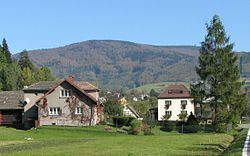Elevation 410 m (1,350 ft) Area 28.19 km² Population 1,988 (2011) | First mentioned 1430 Postal code 739 96 Local time Tuesday 2:57 PM | |
 | ||
Weather 13°C, Wind W at 13 km/h, 60% Humidity Points of interest Czantoria Wielka, Rozhledna Velká Čantoryje, Hluchová, Filipka | ||
Nýdek (Polish: Nydek , German: Niedek) is a village in Frýdek-Místek District, Moravian-Silesian Region, Czech Republic. It has a population of 1,952 (2001 census), 26.6% of the population are the Poles.
Contents
Map of 739 95 N%C3%BDdek, Czechia
It lies on the slopes of the Silesian Beskids mountain range, in the historical region of Cieszyn Silesia. Hluchová River flows through the village.
The name of the village is of uncertain origins and various explanations are expressed. One states it is derived from German Niedeck, another one that from personal name Nidek.
History
The village was first mentioned in a written document in 1430 as Nidek. Politically the village belonged then to the Duchy of Teschen, formed in 1290 in the process of feudal fragmentation of Poland and was ruled by a local branch of Piast dynasty. In 1327 the duchy became a fee of the Kingdom of Bohemia, which after 1526 became part of the Habsburg Monarchy.
After 1540s Protestant Reformation prevailed in the Duchy of Teschen and later local Lutherans built a wooden church here (it was not built earlier by Catholics). It was taken from them (as one from around fifty buildings) in the region by a special commission and given back to the Roman Catholic Church on 21 March 1654.
The village with Lyžbice was bought from Joseph Freyherrn von Beess by Teschener Kammer in 1792 for 46,000 florins.
After Revolutions of 1848 in the Austrian Empire a modern municipal division was introduced in the re-established Austrian Silesia. The village as a municipality was subscribed to the political district of Teschen and the legal district of Jablunkau. According to the censuses conducted in 1880, 1890, 1900 and 1910 the population of the municipality grew from 1,567 in 1880 to 1,747 in 1910 with a majority being native Polish-speakers (between 94.7% and 97.7%) accompanied by German-speaking (at most 74 or 4% in 1900) and Czech-speaking people (at most 17 or 0.9% in 1880). In terms of religion in 1910 the majority were Protestants (93.6%), followed by Roman Catholics (86 or 4.9%), Jews (7 or 0.4%) and 19 others. The village was also traditionally inhabited by Cieszyn Vlachs, speaking Cieszyn Silesian dialect.
After World War I, fall of Austria-Hungary, Polish–Czechoslovak War and the division of Cieszyn Silesia in 1920, it became a part of Czechoslovakia. Following the Munich Agreement, in October 1938 together with the Zaolzie region it was annexed by Poland, administratively adjoined to Cieszyn County of Silesian Voivodeship. It was then annexed by Nazi Germany at the beginning of World War II. After the war it was restored to Czechoslovakia.
